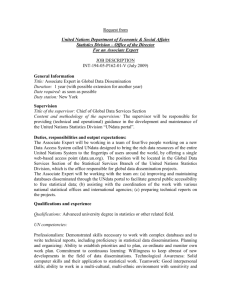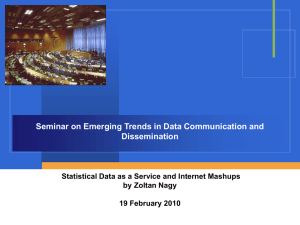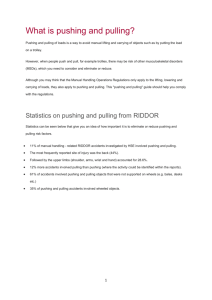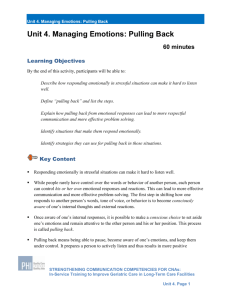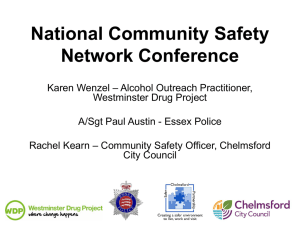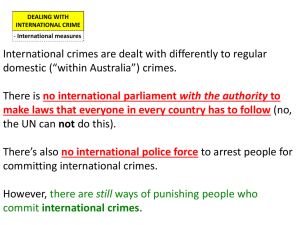International Statistics: Who, What, When, Where, Why and How?
advertisement
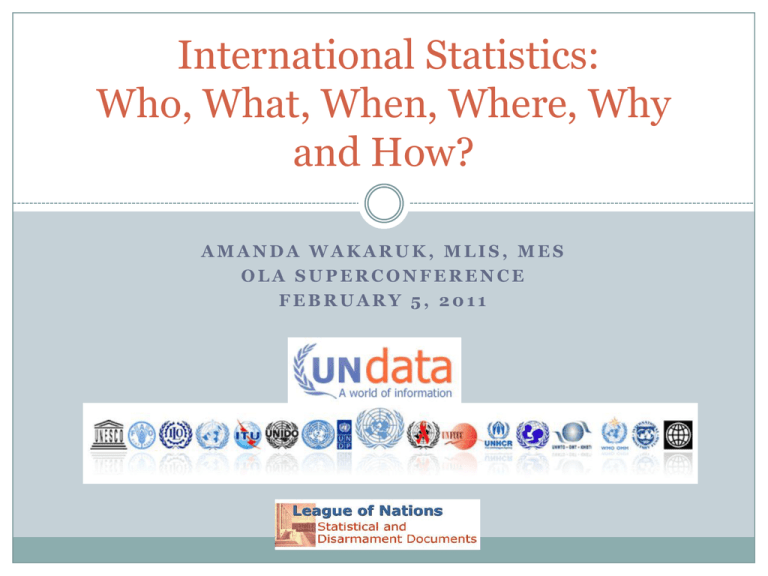
International Statistics: Who, What, When, Where, Why and How? AMANDA WAKARUK, MLIS, MES OLA SUPERCONFERENCE FEBRUARY 5, 2011 The 5 Ws & 1 H I keep six honest serving-men (They taught me all I knew); Their names are What and Why and When And How and Where and Who. Rudyard Kipling. The Elephant’s Child. Just So Stories. Reordering the The 5Ws & 1H of International Statistics WHY ARE INTERNATIONAL STATISTICS IMPORTANT? WHAT ARE THEY MADE OF? WHO COMPILES THEM? WHEN DID THIS ALL START? WHERE DO I GO TO FIND THEM? HOW DO I WORK WITH THEM? WHY are international statistics important? Statistics help us make sense of our world. “the share of democracies increased from less than a third of countries in the early 1970s to more than half in 1996 and to three-fifths in 2008” Human Development Report 2010. United Nations Development Programme.. 2010, pg. 68. WHY are international statistics important? Statistics help us make sense of our world. “Since the 1980s AIDS has slashed life expectancy in Southern Africa… in the most affected countries life expectancy is now below 51 years; in Lesotho it stands at 46—similar to that in England before the Industrial Revolution.” Human Development Report 2010. United Nations Development Programme.. 2010, pg. 32. WHY are international statistics important? Ideally, policy decisions are informed by reliable, timely statistics. “$19 billion in new federal stimulus under Canada's Economic Action Plan to create and maintain jobs.” Introduction. Federal Budget 2010. WHY are international statistics important? Ideally, policy decisions are informed by reliable, timely statistics. “Unemployment has risen in most countries. The increase is 116 percent in Chile, 77 percent in Estonia and Sweden…” “Increase in World Unemployment.” The Times. April 1, 1933., pg. 9. WHY are international statistics important? Statistics help us make sense of our world… critical thinking informs understanding. “Canada’s overall crime rate is now 50 percent higher than the crime rate in the United States. Read that again slowly – it seems incredible, but it’s true.” David Frum. “Reaping what we sow.” National Post. Jan 3, 2006. pg. A14. Gardner, D. “Crime story depends on the teller.” The Ottawa Citizen, Feb 15, 2006. p. A13. Selley, Chris. “Crime and Embellishment.” TartCider Blog. Jan 6, 2006. http://www.tartcider.com/blog/archives/2006/01/crime_and_embel.html WHY are international statistics important? Statistics help us make sense of our world… critical thinking informs understanding. “Each year since 1988, Chinese officials have reported a steady rise in the number of fish caught off China’s shores, even as fish stocks almost everywhere else have declined... according to the Food and Agriculture Organization... local officials passed inflated numbers to Beijing officials, who simply added them up without validating them, and sent them along to the United Nations.” Piore, A. & Mooney, P. (2002, January 21). “China’s statistics are fishier than its oceans; why the PRC overcounts its annual catch.” Newsweek, 46. data/statistics collected/compiled by national statistical agencies/offices: WHAT are international statistics made of? Statistics Canada US Bureaus (e.g., Census, Economic Analysis, Labor Stats, Justice Stats) Institut Haïtien de Statistique et d’Informatique National Bureau of Statistics of China NSAs are listed on the United Nations Statistics Division web site data sources administrative survey-based WHAT are international statistics made of? Statistical Capacity (World Bank): the ability of countries to meet user needs for good quality statistics – usually those statistics that are consider to be “official” (i.e. those statistics produced by governments as a public good). National Statistical Offices are informed by IGO policies and assistance. Fundamental Principles of Official Statistics (United Nations Statistical Commission) Handbook of Statistical Organization (United Nations Statistics Division) Technical assistance, training, financial support. International Governmental Organizations WHO compiles international statistics? United Nations UN Statistical Commission, UN Statistical Division (UNData, Comtrade) International Labour Organization World Health Organization World Bank (dataBank) International Monetary Fund (IFS) Human Development Programme (Human Development Report) OECD European Union (Eurostat, Bookshop) 1853-1918: various statistical congress/society meetings pre-1900: piecemeal at best; few censuses 1919-1946 : League of Nations (1926-1944 Statistical Yearbook via Northwestern University) WHEN did this all start? WHO, ILO established 1946: United Nations Statistical Office 1953: System of National Accounts 1965: UNDP (HDR 1990) 2002: Inter‐Agency Committee for the Coordination of Statistical Activities 2007: “We have a system of global statistics but not a global statistical system.” (UNSD Seminar on the Evolution of National Statistical Systems) “I had to become the Robin Hood for free data,” Dr. Hans Rosling. “Making Data Dance.” The Economist, Dec 10, 2010. Reference interview: time period, geography, indicator. 2. If it’s unfamiliar territory, start with a web/literature search. 3. Find the *source* of statistics noted in the literature. Follow that lead! 4. Check UNData: read the footnotes and fine print; mine the meta-data for context and other publications/sources. 1. WHERE do I go to find international statistics? Depends on where you start! UNdata http://data.un.org/ UNdata sources UNdata topics UNdata WDI UNdata WDI HOW do I work with international statistics? Literature Search FOR CONTEXT AND LEADS ONLY add “statistics” as a search term learn the language identify important publications from authoritative compilers (i.e., UN agencies)… follow those leads UNData http://data.un.org/ manipulate, download statistical series mine meta-data for context/definitions investigate references for fuller series Pulling it Together What percentage of people “go hungry” in Canada, the United States, Haiti, and the Dominican Republic? World News: U.N. says world hunger is declining Scott Kilman, 15 September 2010, The Wall Street Journal Europe “The United Nations' Food and Agriculture Organization in Rome estimated that the number of hungry people in the world will drop 9.6% this year to 925 million, the first decline in 15 years.” UN urges long-term solutions to help countries with protracted food crises recover 7 October 2010 WebNewsWire “Chronic hunger and food insecurity is the most common characteristic of a protracted crisis, according to the report, the State of Food Insecurity in the World 2010, published jointly by Food and Agriculture Organization (FAO) and the World Food Programme (WFP).” Pulling it Together Pulling it Together Pulling it Together Pulling it Together How many people are undernourished in the world? Pulling it Together Pulling it Together Pulling it Together Pulling it Together Pulling it Together Pulling it Together Pulling it Together Pulling it Together The 5Ws & 1H of International Statistics WHY ARE INTERNATIONAL STATISTICS IMPORTANT? WHAT ARE THEY MADE OF? WHO COMPILES THEM? WHEN DID THIS ALL START? WHERE DO I GO TO FIND THEM? HOW DO I WORK WITH THEM? The 5Ws & 1H of This Presentation WHY ISN’T EVERYONE EXCITED ABOUT INTERNATIONAL STATISTICS? WHAT DID I DO WITHOUT THEM? WHO CAN I TRUST TO PRODUCE THEM? WHEN CAN I START USING THEM? WHERE CAN I INTEGRATE THEM INTO CLASSROOM/DESK WORK? HOW DO I SHARE THIS WITH MY COLLEAGUES? Questions? AMANDA WAKARUK, MLIS, MES GOVERNMENT DOCUMENTS LIBRARIAN UNIVERSITY OF ALEBRTA AMANDA.WAKARUK@UALBERTA.CA
